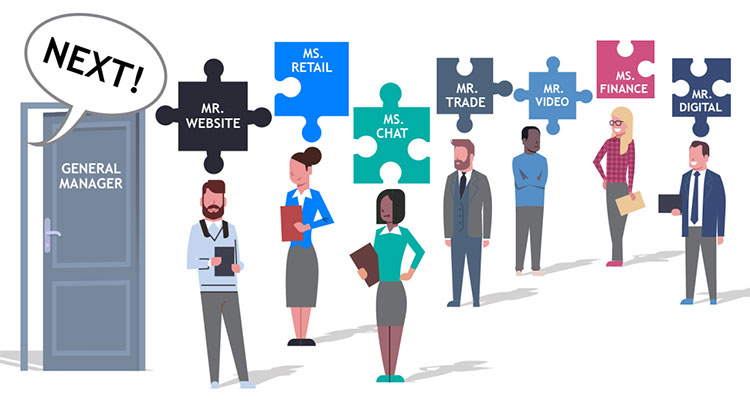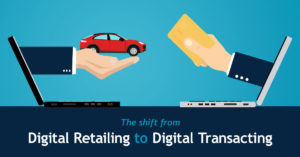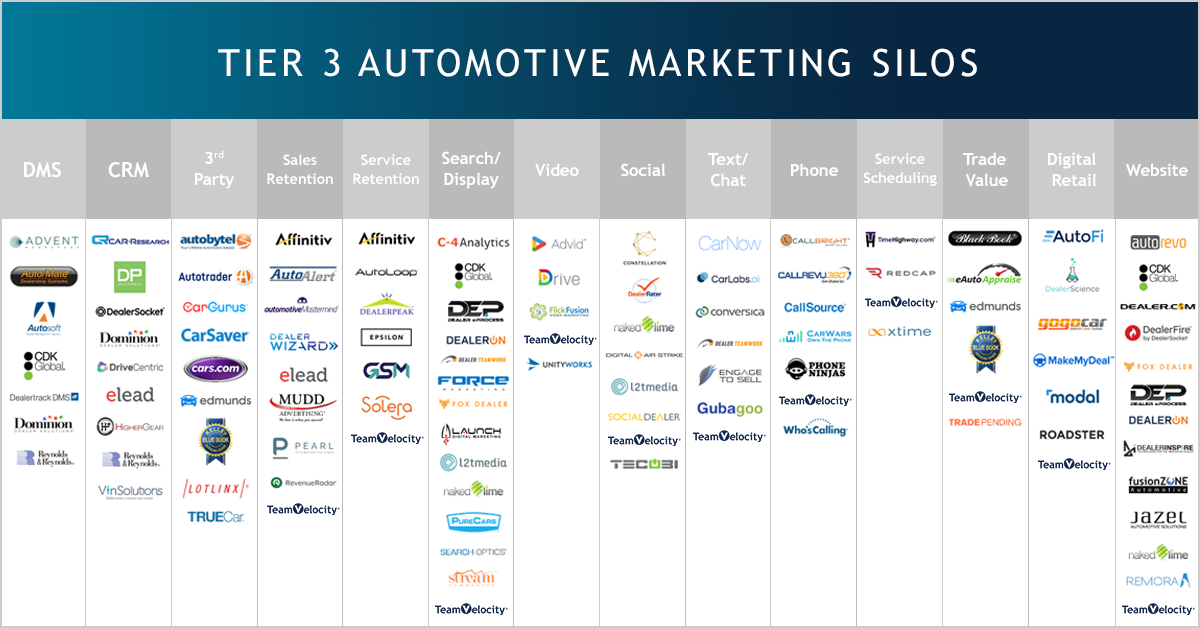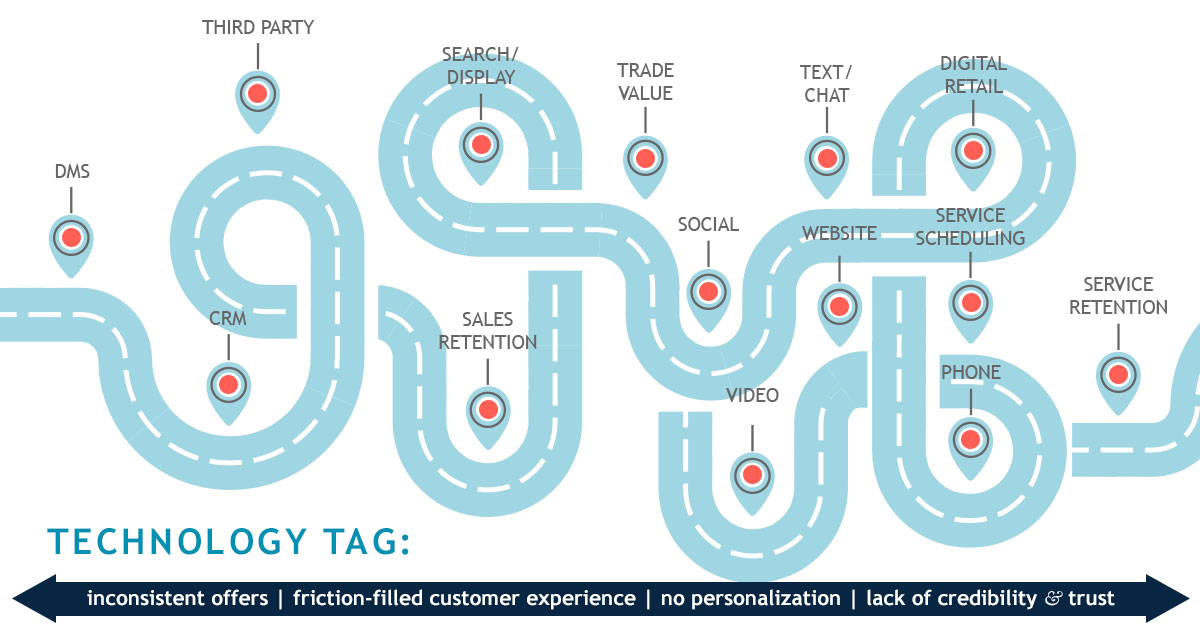Stop Stitching. Start Integrating.
Everyone says they’re integrated. But do they mean it? The problem that our industry suffers from at large is a poor customer experience.
Everyone says they’re integrated. But do they mean it? The problem that our industry suffers from at large is a poor customer experience.
Recent research shows only 1% of dealership websites meet Google’s Core Web Vital standards, the most basic benchmarks for site speed and performance. Why so low?
There came a time when just stepping into a car dealership felt a bit like walking into a high-stakes poker game: Everyone had to prepare themselves for a bluff or a hidden card up someone’s sleeve.
Did you know that nearly 70% of car buyers feel misled by advertised pricing, and 1 in 4 would switch dealerships over trust issues?
This year’s NADA conference once again brought industry leaders, innovators, and trailblazers together in Las Vegas. Within the inevitable buzz and excitement that we see year after year at the industry’s biggest event, we noticed a few major themes that remained relevant throughout. Let’s dive into them.
As the dust settles on the changing automotive landscape in 2023, it has become clear that last year was a crucible of transformation and invaluable insights. From shifts in consumer behavior to redefined dealership practices, it’s safe to say the industry will never be the same. The impact this year will have on the next is substantial, and dealers should continue adapting to the ever-evolving industry in order to stay ahead of the curve.
It’s time to discuss the top trends from 2023, and start to think about what the industry holds for us in 2024.
So, as we reflect on this past year and move into the next, it’s imperative to keep a pulse on where the auto industry is headed. The rapid integration and expansion of emerging technology underscores the desperate need for adaptability in dealership practices. Automotive is continuously proving to be an extremely dynamic industry full of opportunity: to innovate, to thrive, to forge your own path. Will you be ready to seize it?
David Boice
Team Velocity Co-Founder & CEO

Website: Hi, my name is Website. Thanks for stopping by. How can I help you today?
Customer: Hey, we are looking to check out the new 2022 Telluride, see what our trade might be worth, and get a feel for of our monthly payments to see if it works in our budget. If so, we are interested in purchasing over the next few days.
Website: Perfect, let me show you around. BTW, how did you hear about us?
Customer: Your friends, Google and Facebook, suggested you. They said your offers on the 2022 Telluride were awesome!
Website: Ok, but first just a word of caution. Whatever you and Google and Facebook discussed privately may not be the same information you get here. But not a big deal, right?
Anyway, let me introduce you to my helpful widget friends. Just to name a few…This is Chat, that’s Trade, and over there is Video. My friend Finance is awesome, VDP is my main man, and you might even get to meet Retail, but most people don’t get that far.
Let’s get started with Chat. Just so you know, she will jump around frantically to get your attention and bug you all day long, unless you just say “hi” and tell her who you are. If I were you, I would just do it, because if you don’t, she is never going away. No matter what. Seriously dude, I am not joking around. I see it all day long. It’s actually crazy.
Chat: Hey, how may I help you today?
Customer: Hi, can you start with giving me some info on the new Telluride?
Chat: Slow your roll stranger. How about you start by giving me all of your information in case you decide to leave quickly, and a member of my team needs to reach you…like maybe tomorrow, probably… or at some point soon?
Customer: Ok, I am already here though. Why can’t they just speak with me right now, before I leave? But, fine, here is all my contact info. Now can you please let me know about that new ’22 Telluride?
Chat: Hmmm, that is such an incredible question. Hang on for a minute while I check. Darn it, Customer. I am afraid a member of my team cannot answer your question, but we will try our best to call you back tomorrow, hopefully. Is there anything else I can possibly do for you today?
Customer: You have not done one single thing for me today. Literally.
Website: Hey Customer, welcome back. Just so you know I cannot see or hear anything that any of my widget friends say or do. It’s like they live in their own world. But let’s get you straight over to Trade and see what happens.
Trade: Hi there. Tell me all about your trade, and then I will obviously need all of your contact information, and then I can send you a value report.
Customer: Ok, here is all my trade information, but I literally just gave Chat all my contact info, can’t you get it from her? Don’t you all work here? It’s the exact same information she just asked for 30 seconds ago.
Trade: Listen Customer, I can see you are already frustrated because you have not gotten a single bit of useful information since you arrived and have repeatedly been asked to identify yourself. I am sorry to say that this is only the beginning. Every other widget friend will need the same information. It’s what we are born to do. We cannot share your information because technically, none of us work here. We are employed and powered by other companies. See my real logo. It’s better to think of us all as “certified” and completely independent contractors. We can only keep our job if we prove to the boss that each of us have separately obtained your contact information. It’s like our fun game. Anyway, then we send your info over to CRM. He is getting old; he still counts the leads with his 20-year-old ADF calculator. Does that make sense Customer, in some small way?
Customer: No, not even in the slightest. I came here to get information to buy a Telluride. So far, all you want is for me to give you information to send to CRM. I thought you wanted to sell me a new Telluride. Google had me so convinced I could get a great deal, and it would be easy.
Website: Hey buddy, welcome back. I get it, just keep your chin up. I am going to get you straight over to my main man, the one and only VDP. We try and make sure everyone here meets him.
VDP: Hey Customer, I promise I am going to get you exactly what you need. Sounds like someone needs a great price and a payment on this 2022 Telluride. Am I right?
Customer: Yes, thank you VDP. You seem friendly with Website, so can you please tell me how much our monthly payment would be on this Telluride, including our trade information that I just gave your colleague, Trade.
VDP: Didn’t Website already explain all that? Whatever info you gave Trade stays with Trade. Sorry, I basically need all your exact same information. Relax, take a breath, because you may or may not like this… but the “awesome offers” you first saw from Google, or anywhere else, before we met are not actually our very best price. Isn’t that surprisingly fantastic news? We have something special called an E-Price. BTW, nobody knows what the “E” stands for. I am pretty sure it’s supposed to be like our “Extra” Special very best price. But it is not here now, it’s in a secret hiding place. All I need is your information and a spot to send this extra special E-Price because you understand I cannot exactly give it you now, right? I hope you get it. Fingers crossed.
Customer: Whaaaat? We are standing in the middle of your showroom right now, and we are ready to buy a Telluride. I don’t get it? I already gave your widget friends all my information and I just want to know an idea of my extra special payments NOW. That’s why we came here in the first place. Is that too much to ask, VDP? I mean, isn’t this a super common question?
VDP: Chill Customer. Please don’t bounce on me. We do have one final last-ditch option, and that’s to introduce you to the biggest, baddest widget friend in the dealership, Retail. But I am warning you, once you two meet, we may never see you again. She is a lone wolf with her own unique style and has her own entirely separate way of doing things. But perhaps she just might be able to help you. Really, at this point what do you have to lose? Are you ready?
Customer: Sure, let me meet her. But first, please tell me that all your other widget friends, or you, Website, already gave her all my contact information, all my trade information, and all my shopping history. I can’t take explaining this 2022 Telluride again and again. I don’t want to answer the same questions again. PLEASE!
Retail: Hey Customer, you look beat. By the way, what’s your real name? If I am going to help you, we need to start over fresh, and I do not want to hear about your time with Google, Facebook, or Website either. That’s all in the past.
Customer: Seriously, Retail? You also need my contact information, trade information and the details of what I want, too? And why are your prices and payments different than your associates, Google, Facebook, and Website? Are you joking?
Retail: Nope. Look, whatever your name is, only 3% or so of people even get this far. You should feel great about your effort. You have worked so hard and met so many widgets. Let’s finish this thing. Now, again, what’s your name, how can I reach you later, what are you trading, and how are you paying for it?
Customer: OMG! Do you even know Website, VDP, Chat, or any of the other people I have dealt with along the way? And shouldn’t Website have been able to just give me all this basic information himself, quickly? I still do not have an ounce of information I originally asked for. It’s so maddening.
Retail: Look, I admit I do not know them well. Except we go to conferences together and party like rockstars 😊. But, just between us, I am always the last person you’re gonna meet. It’s just how it works at our dealership. Now, like I said, let’s relax and start from scratch. It’s much easier if we both pretend everything that happened before we met is erased from your memory like it never happened. Even though it did.
Customer: You have got to be kidding me.
If you know the automotive landscape, I hope you enjoyed a laugh or two, like I did while writing this. While fun to smile, we are seriously devoted to creating solutions that empower retailers to dramatically improve their customers’ experience, both online and offline.
The bottom line is this…a dealer’s sales process (inside their stores) would never mimic the online sales experience. I would argue the customer experience is currently far better, more informative, and logical inside the dealership. Online, it’s typically disjointed from the first click of an email or a digital ad all the way through to a website filled with widgets. It’s even worse on mobile devices. The current online shopping journey takes consumers from one siloed experience to another, littered with distractions along the way. This ecosystem has slowly developed over 20 years and was not designed to easily facilitate the most important result: a transaction. Dealerships cannot efficiently manage 8-10 companies, all with individual goals and technology, and expect to create a meaningful customer experience that generates a great outcome for their business.
Integration is a change already established in most other industries, but not automotive retail… yet.
I call it “Mission Improbable” because the current ecosystem was developed like separate pieces of a puzzle that were never designed to fit. Given the exceptional online experiences customers have in other areas of their lives, it’s improbable they will play hopscotch through the maze of inconsistencies in both offers and user experiences. This siloed ecosystem is unique to automotive, and it’s heavily supported by a financial model that rewards silos, OEM certifications, etc. It’s become the norm.
But what are the alternatives? I see two logical pathways to improvement. The first would be a format to share customers’ contact information and shopping data across different platforms. Real integration between various technologies. But, the chances of wide enough adoption are unlikely because the level of cooperation would require tech companies that fiercely compete to also agree. On top of that, growing consumer privacy regulations and security environments would prove challenging.
The more likely alternative is the birth of all-inclusive platforms that were designed, acquired, or both, to facilitate the entire customer journey from the creation and first click of an ad to the final click of scheduling a sales delivery or service, without any unnecessary interruptions, all originally engineered to work together seamlessly. But, platforms like this will take time to adopt because investors, dealers, and OEMs are accustomed to the current mindset. Integration is a change already established in most other industries, but not automotive retail… yet.
We are passionately committed to a better alternative that is facilitated by one, fully-integrated technology platform, designed from the ground up for all “widgets” to work together for customers and dealerships. It is how the rest of the world is already retailing, and we believe we can too.
David Boice
Team Velocity Co-Founder & CEO

Each week, a growing number of new or prospective clients ask us to provide, “whatever (insert dealer name) is doing that is working so well.” The belief being, if they work with the same company and use the same technology, the results will also be the same. Maybe, maybe not.
We are fortunate to serve many OEM’s and over 1500 progressive dealers in the automotive, RV, Powersports, marine, and motorcycle industries. A common belief amongst them is that by substantially improving and personalizing their customer’s experience, they will, in turn, complete more transactions. In this regard, they are customer experience mavericks. Their belief system (and ours) has formed the entire basis for our Apollo technology platform.
Before you try to emulate a dealer, you perceive as successful, I would encourage you also to evaluate changing the way you think about retail. We know that change, whether good or bad, is resisted with equal intensity. While that is true for humans, it is even more true for organizations.
To be as successful as a progressive retailer, it requires more than just switching companies. It requires re-thinking as well. One change, without the other, is a formula for continuously switching vendors or strategies and then wondering why you are not getting similar results.
Here are five out of a list of many real-world examples of how progressive dealers think versus a typical retailer. So, before you change companies, ask yourself, are you ready to be like dealers who think this way?
1.) Let us start with an easy one–scheduling service online. Progressive dealers want fewer inbound phone calls and chats to schedule service. Is that a typo? No. They think scheduling services online should be easier and faster and ideally completed with just a few simple clicks or voice commands. The common thinking and old KPI’s reward conversion metrics for more calls and chats. The more conversions, the better, right? Wrong. Progressive dealers consider those KPIs outdated, less attractive, and not in the best interest of their customers. Ideally, they want most service appointments to be scheduled online without ever requiring a customer to speak with a human or chat with a bot. More online service appointments and fewer inbound calls/chats equal fewer failure points with decreased operating expenses.
2.) Progressive dealers believe in providing customers with all the information they need online to complete a sales or service transaction quickly and efficiently. Providing their contact information is only a voluntary step along the way. Traditional thinking requires the customer to provide all their contact information as a necessary first step. Most dealership advertising and websites are littered with interruptions during the process of requesting contact information. Innovative dealers need traditional leads but focus more on developing a seamless information-based customer experience without interruption.
3.) Progressive dealers believe the primary purpose of their website is to facilitate sales and service transactions. Commonly, automotive websites are overwhelmed with slow 3rd party widgets solely designed to extract contact information from consumers in exchange for the promise of a better deal, accurate price or payment, higher trade value, etc. Conversions, not transactions, are King. Progressive dealers believe these constant distractions undermine the very purpose of their website, which is to help them sell and service more cars.
4.) Progressive dealers believe in the value of humans answering inbound texts during business hours. As a percentage, there is no higher type of engagement that converts to a sales or service transaction better than a well-written text exchange between humans. Text is, by far, the most preferred method of communication among adults in the US. Unfortunately, typical thinking is to outsource 100% of these opportunities to bots that cleverly gather customer contact information and routinely end with “Sorry I can’t help you with that. A member of our team will contact you”. A phone call is an opposite outcome the consumer prefers, but ideal for typical retailers who believe their websites should primarily extract information from consumers so they can follow up later. So, rather than having a live exchange upfront, they delay a potential transaction with the hope of reaching a customer later. Progressive dealers think that is illogical.
5.) Progressive dealers prefer fewer technology applications with deeper integration for the companies they choose. Conversely, traditional thinking is, “We cannot put all of our eggs in fewer baskets.” Dealers who think like this often work with 15 or more companies to string together a disjointed customer experience. Progressive dealers gain their inspiration from companies like Tesla, Carvana, Amazon, and others with innovative, fully integrated platforms like Apollo, which provide information and facilitate transactions openly.
Progressive thinking is hard to adjust to because, for 20 years, marketing efforts and websites have delivered a high volume of lead forms and phone calls, not transactions–two distinctly different outcomes. Tesla, Carvana, Vroom, and others have designed their entire platform from scratch (without widgets or independent retailing tools) to facilitate transactions. Their main call to action is to create a secure online account that allows consumers to facilitate a transaction from start to finish. Everything else is a distraction in achieving that goal. We agree.
The company and technology you choose should reflect how you feel about retailing. Before you make the switch, ensure you are equally committed to thinking differently. Your belief system will dictate your success. Take some time to think about it upfront, so when something does not go as planned, you can stay the course. Along with our progressive clients, we believe the 20-year-old KPIs are outdated and increasingly less useful. Completing sales and service transactions with simplicity and ease should be considered the new standard for success.

This Thursday, April 16th, I am hosting a webinar with Automotive News to discuss the future of digital retailing and its necessary evolution in the current customer experience landscape. At NADA, we launched our website platform, Apollo Sites. Since then, I have answered the questions below hundreds of times and thought it might be helpful to publish in advance of the Automotive News webinar.
Q: Why is Team Velocity adding primary websites to its Apollo platform?
A: Here are the top 5 reasons in no specific order:
Q: Do Apollo Sites have a digital retailing solution? If so, what’s different?
A: Yes. Apollo Sites has a digital retailing application called Transact. It’s unique from other digital retailing tools because it’s built natively into the entire website platform, making it easy for consumers to navigate. Our vision wasn’t to have just another digital retailing tool, but an entire transactional website platform. Transact is fast on mobile devices and uses the same UX as the website. Consumers never leave the dealership’s site and all the reporting is included in the analytics. Also, when current customers sign in, (using something as simple as their phone number or email), all their information is pre-populated, so they never waste time filling out forms, figuring out their trade value, equity, payoff, etc. Existing customers have a very fast and easy ability to complete another sales transaction with ‘one-touch’. This feature is critical for dealerships who have databases they need to retain. The existing digital retailing solutions are plug-ins to a dealer’s primary website with entirely different UX, reporting, etc. And, they treat every customer like the public. We think this is not only illogical but archaic by today’s standards.
Q: How about Service Scheduling? Does Apollo Site have that capability?
A: Yes. Apollo Sites was built with a complete service scheduling application that allows a customer to schedule service in about 45 seconds. Thus far, it’s generating 2-3x the number of online appointments as the leading providers in every implementation. An added benefit is that it automatically runs all service appointments through Apollo’s equity tools to alert the dealership when service customers are in a good position to upgrade, what specific upgrade options are available, and calculates to-the-penny payments for that particular customer. Everything is integrated, so there isn’t a need for any additional expensive equity mining software.
Q: Given the current challenges related to Covid-19, is there any technology to facilitate service and sales transactions outside the dealership?
A: Yes. Even prior to the Covid-19 outbreak, we were building virtual dealership applications to help our large metro dealers go to the customer versus the customer coming to them. What was once a nice benefit has now become a necessity. Every aspect of Apollo Sites allows customers to select options to have their vehicle picked up for service, sign up for test drives completed remotely, and, for vehicles purchased online, to have their new vehicle delivered offsite (if the dealership is capable). All of this is easily managed in Apollo’s appointment system or can be delivered to a dealership’s CRM.
Q: How are the OEMs reacting to the Apollo Sites?
A: Some of our best meetings have been with OEMs because this new technology solves many of the challenges they face. First, because the OEMs are hyper-focused on loyalty rates, the ability to offer existing owners a personalized, custom experience is ideal. Just a 1% gain or loss in retention is substantial for any OEM. Second, Apollo Sites creates a personal website for every customer, pre-establishing a “one to one” relationship. Dealers can immediately offer existing customers their best pricing without forcing a customer to “get e-price or unlock savings” on their website. OEMs love that feature, and some are starting to think about further personalizing incentives with this platform down to the customer level. Third, current website providers basically outsource Fixed Operations to 3rd parties. Service is an afterthought at best, but the OEMs all recognize the relationship between sales, retention and service. We built all service components into the website platform natively, with zero widgets required. Customers love how easy it is to schedule service, check their service history, get their own custom coupons, have their vehicle appraised while their car is in for service and the ability to check their vehicle’s value anytime. The first major OEM who reviewed the Apollo Sites website platform quickly added us to their list of approved providers, which was a very encouraging sign for our dealerships.
Q: What inspired the innovation behind Apollo Sites?
A: It’s just all new thinking. And RE-THINKING what we thought we knew. We were most inspired by the concept of Amazon Prime. Nothing in our industry, except perhaps Tesla and Carvana, have fully adapted to meet the consumer’s expectations. The current offerings lack the kind of thinking and features our clients expect from a website. And we are just getting started with this new integrated website platform. We are re-investing another $6M in 2020 to further improve the Apollo Sites website platform and plan to introduce many features that will be entirely new to our industry. We aim to set a new and very high standard of excellence for both consumer experience and for what dealerships should expect from their websites. Our focus is squarely on facilitating sales and service transactions for both existing and new customers.
Q: The evolution of Apollo to include websites seems like the final piece of the puzzle. Will there be another generation of Apollo?
A: The addition of Apollo Sites has certainly enhanced the entire Apollo platform but there will certainly be another evolution.
Here’s a hint on what we are working on next…
What if a dealer’s website, not their CRM, dynamically generated beautiful, relevant, image-based, follow-up automatically? What if it was based solely on ALL the behavior and data collected on each customer and cross-referenced with the DMS? Just like Amazon, VRBO, etc., when customers complete a sales or service transaction, they automatically get new and relevant messaging. Our goal is to create a smart website that focuses on generating service and sales transactions, not just leads. Dealers have been in a stranglehold with outdated, text-based follow-up emails that don’t work well because ADF-XML technology is literally 20 years old. Yet, everyone still uses it. We consider it digital road-blocking and it kills progress. Think about it and stay tuned.
Want to learn more?
If you want to get a deeper dive on the changes we see coming, please join us with Automotive News on Thursday, April 16th at 2pm. You can register here.

Before I get to the heart of the article…you might rightfully point out that I missed a few large technology silos. You are correct. I ran out of room, so I included the most common and universal categories that apply to franchised dealerships’ most popular sales and service advertising strategies. And, you would also be correct that some excellent companies are missing all together. Agree, let me know who is missing. The companies included are all great at what they do, and I listed them alphabetically. However, adding more silos and logos only makes the reason I am writing this more relevant to the challenges faced by dealerships in the current 2020 ecosystem.
Now, if you are an entrepreneur, what an impressive list of companies that make up much of the technology ecosystem in the automotive industry for advertising. Some of them cover one silo perfectly while others dabble in 2-3 silos. A few of these companies are worth billions of dollars and many worth hundreds of millions. Not bad, right? But when I reviewed this graphic with my dealer friends, I discovered the average number of companies they work with to help sell and service cars was between 10 and 12 from these main ad categories alone — but way more vendors are required. This is just the tip of the iceberg.
I call this “Mission Improbable”, meaning it’s highly improbable this siloed model is going to succeed. Here are some comments from good, really good, retailers who passionately want to create a frictionless customer journey for their new and existing customers and do it in a way their internal teams can efficiently and profitably execute.
“A world-class customer journey isn’t possible with this many companies and competing technologies involved. It’s too hard, so we settle for mediocrity.”
“It’s like a game of Technology Tag and I am always it. Nothing quite works together like we are all promised.”
“We have 8 offer management platforms just to price out cars and create compliant offers. None of them are consistent. It’s no wonder customers lack trust in our process.”
“I have 4 franchises; my OEMs all use different certified vendors in their Co-Op programs. It compounds our challenge by 4x. It’s getting worse every year.”
“It’s too expensive and the real costs are all the people we need to hire, train and re-train in order to use these technologies that were never designed to work together.”
“All these companies are all chasing the exact same people. I only have two types of people to sell or service…my existing customers and prospective new customers in my market. Is it really that hard?”
“We have all been so focused on the customer journey, we all forgot about the dealer journey through all of these independent platforms.”

So, the problem for dealers is logical and well-said by the growing frustration of dealerships who are spending more for technology and getting less of a return, if any.
What’s the solution?
With every big challenge comes a great opportunity to solve it. As we enter the new decade in 2020, I would propose some or all the below suggestions to help combat Mission Improbable.
I am going to be at NADA this year with Team Velocity at Booth #4288C in the main hall. If you want to talk more about this, or set up a time to see how we are solving the game of Technology Tag, please send me a private message.